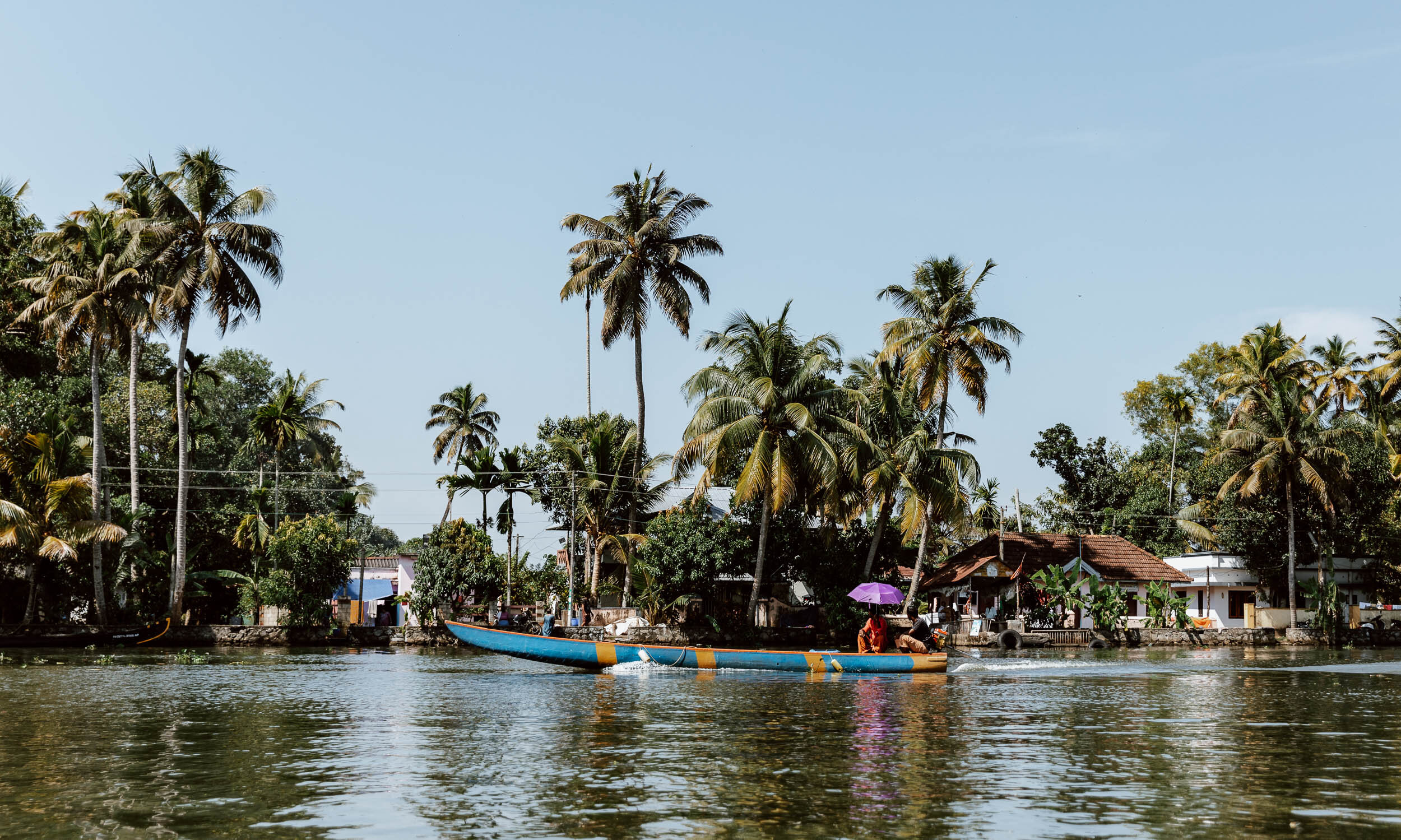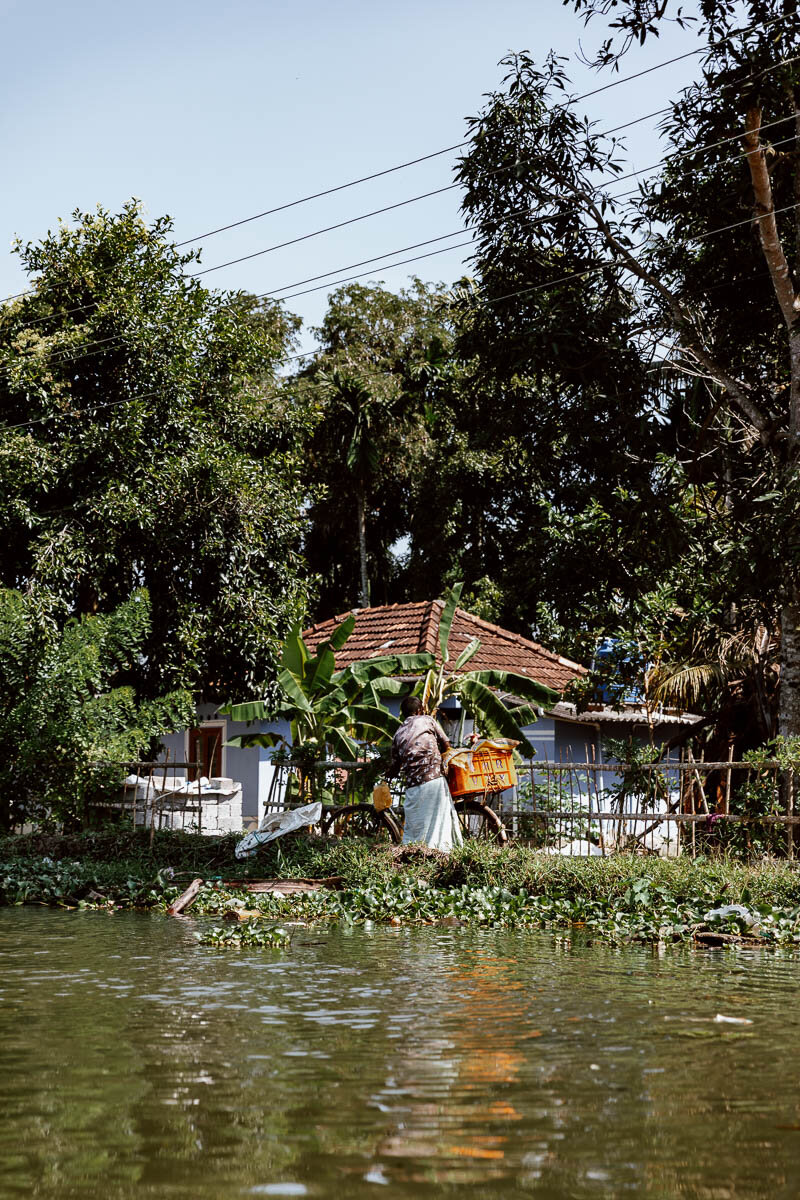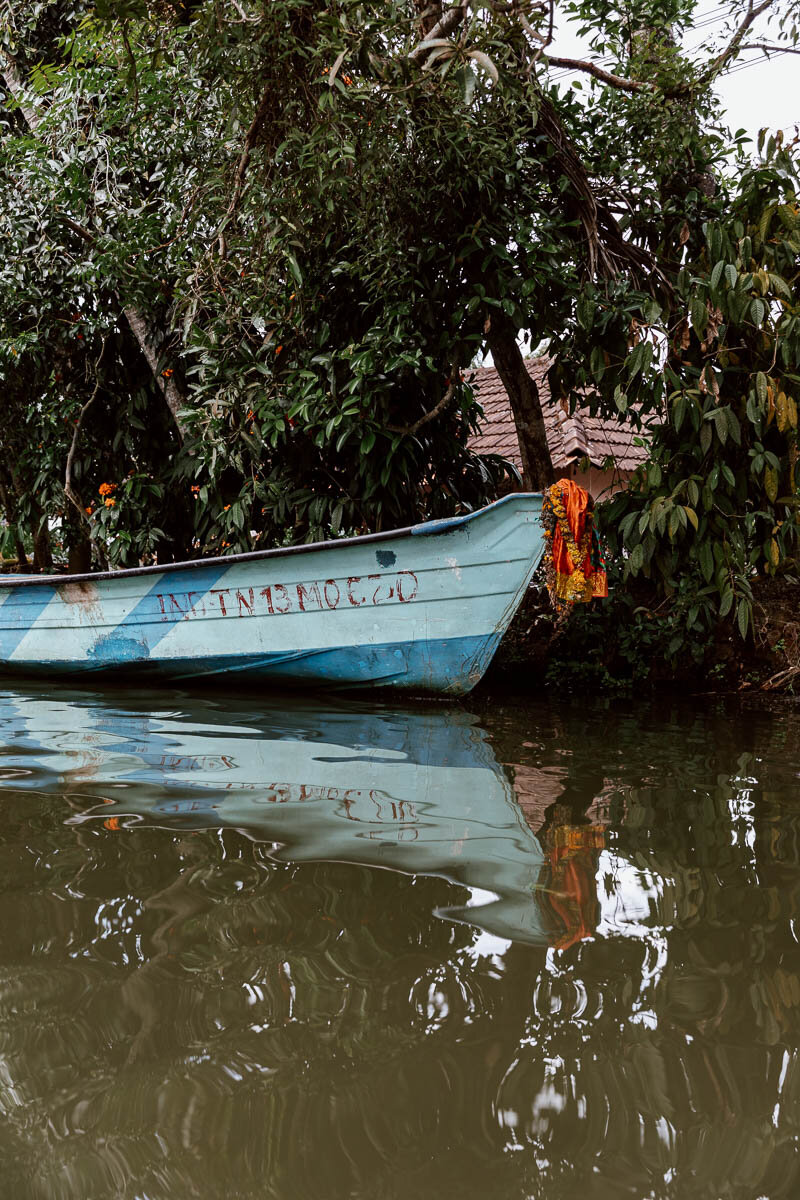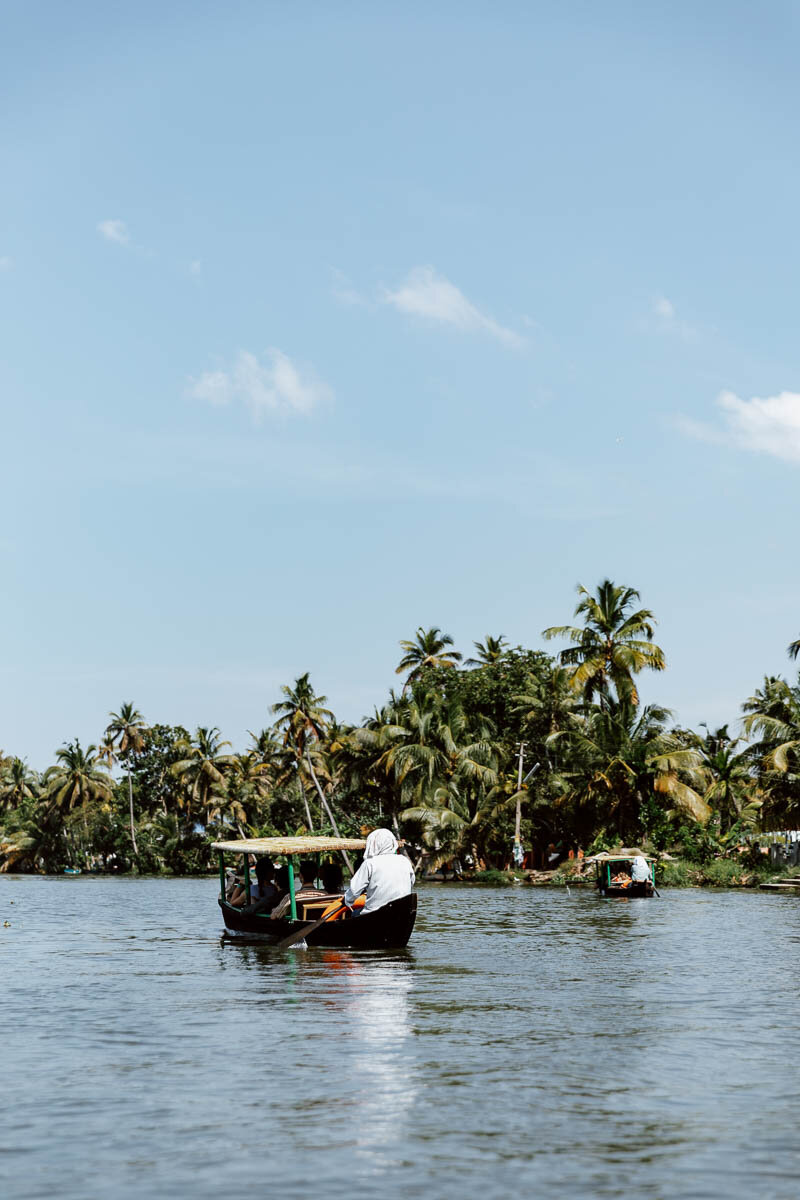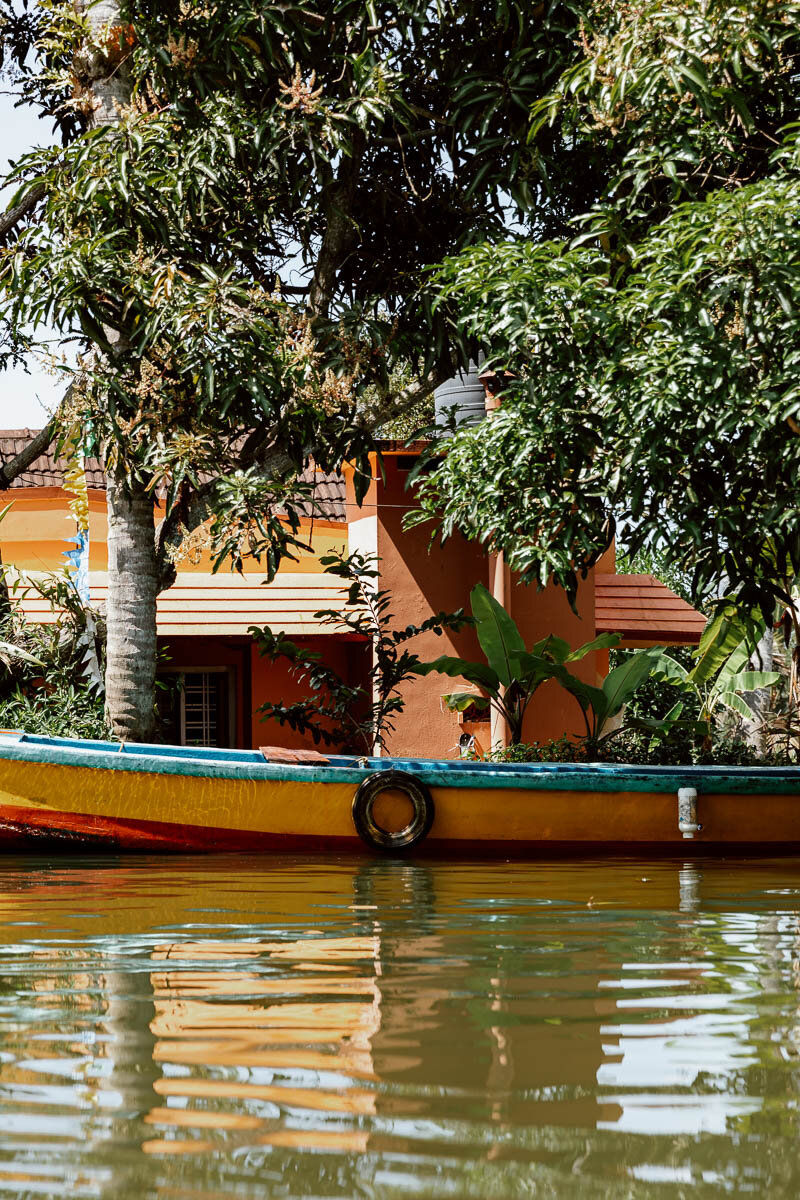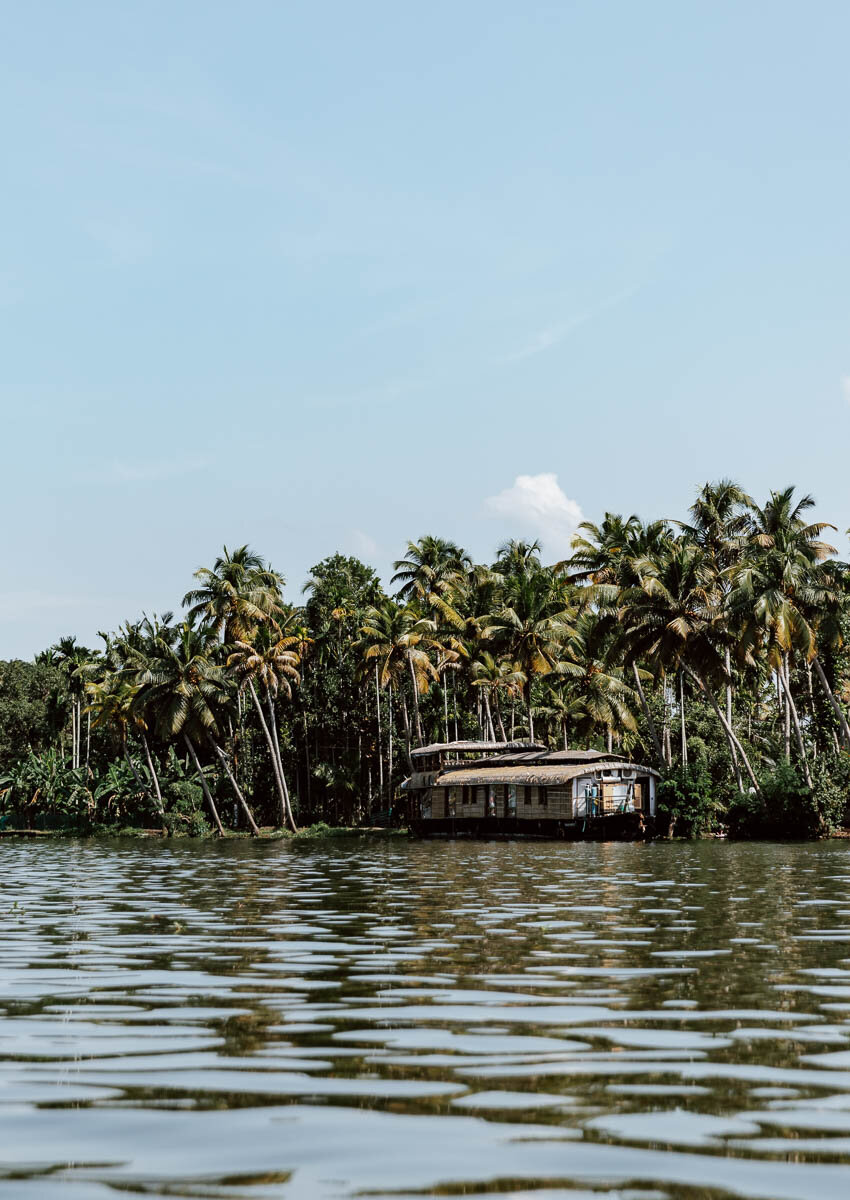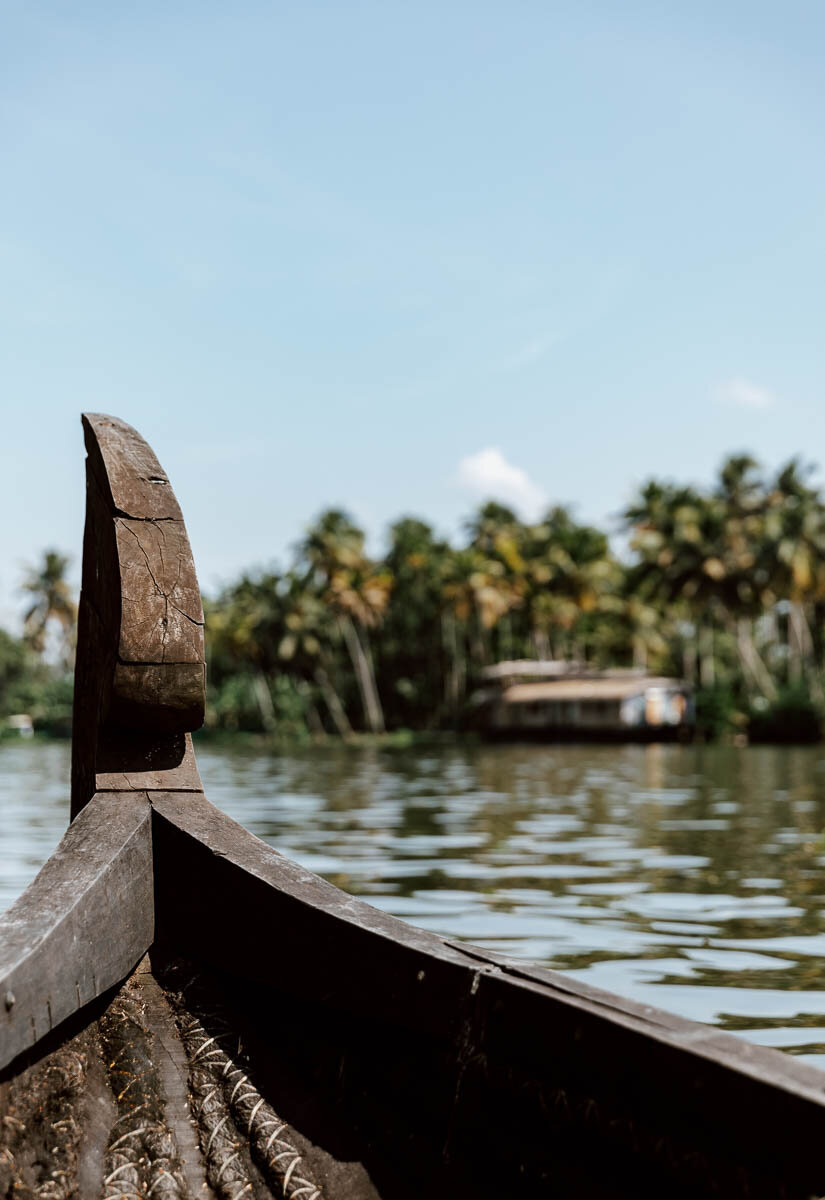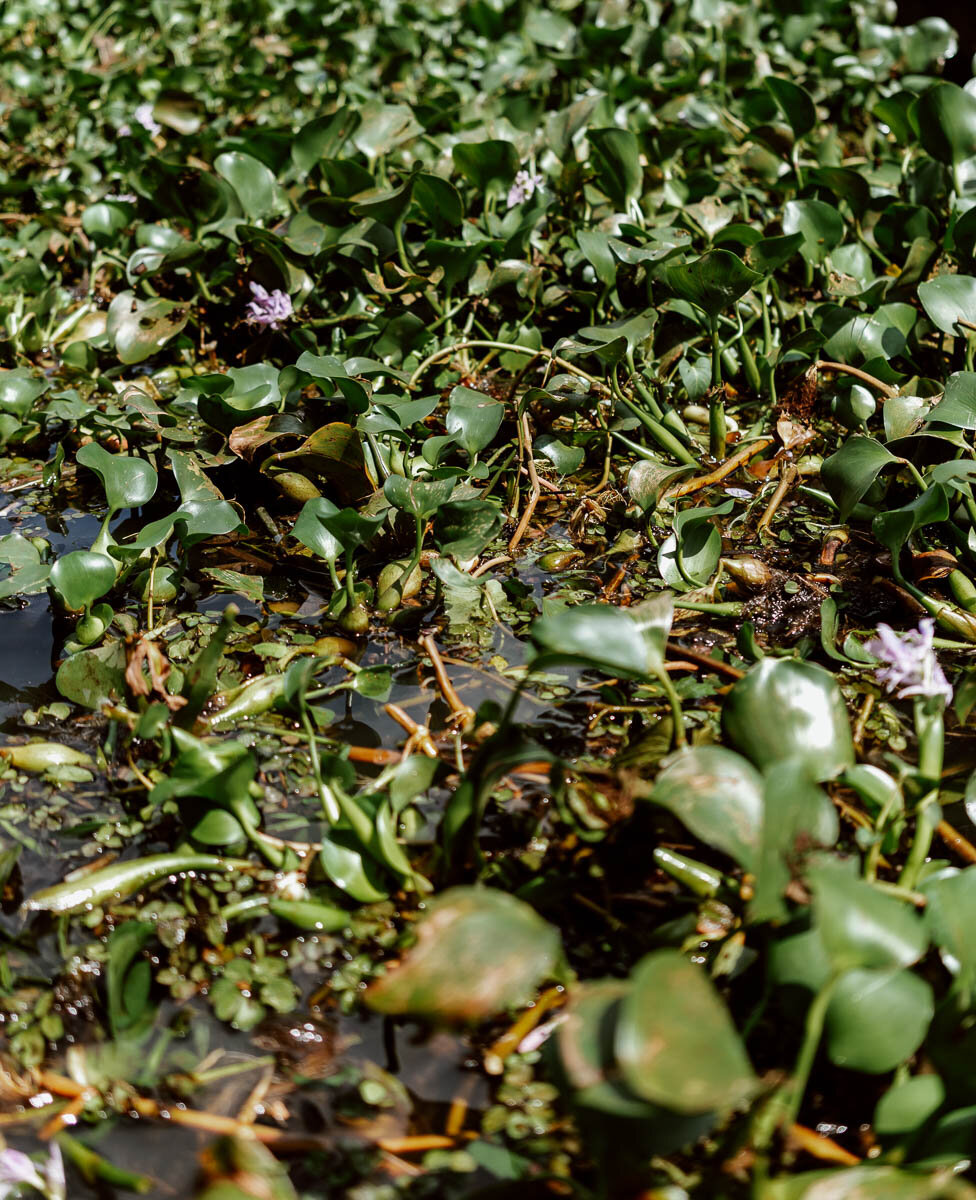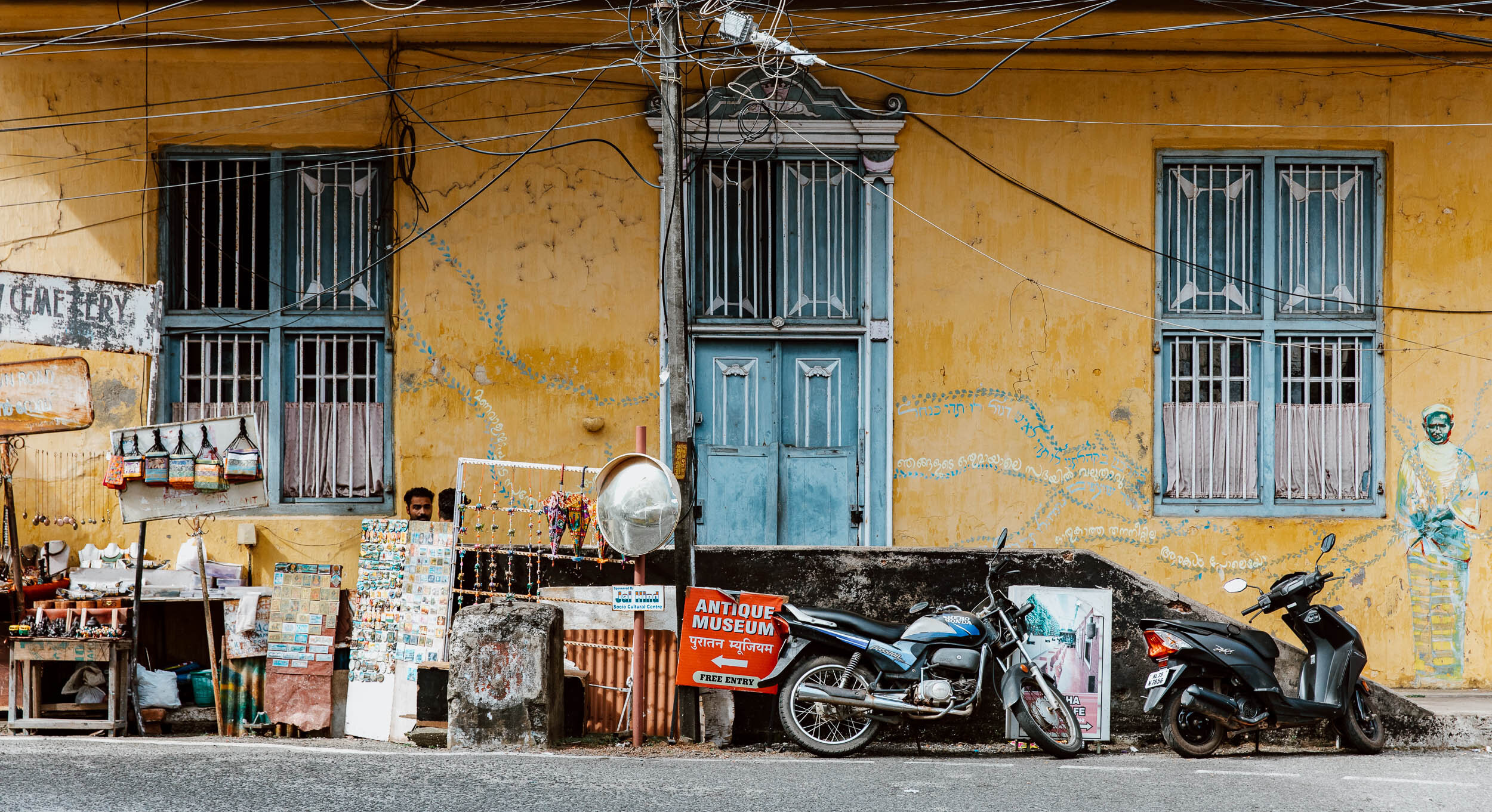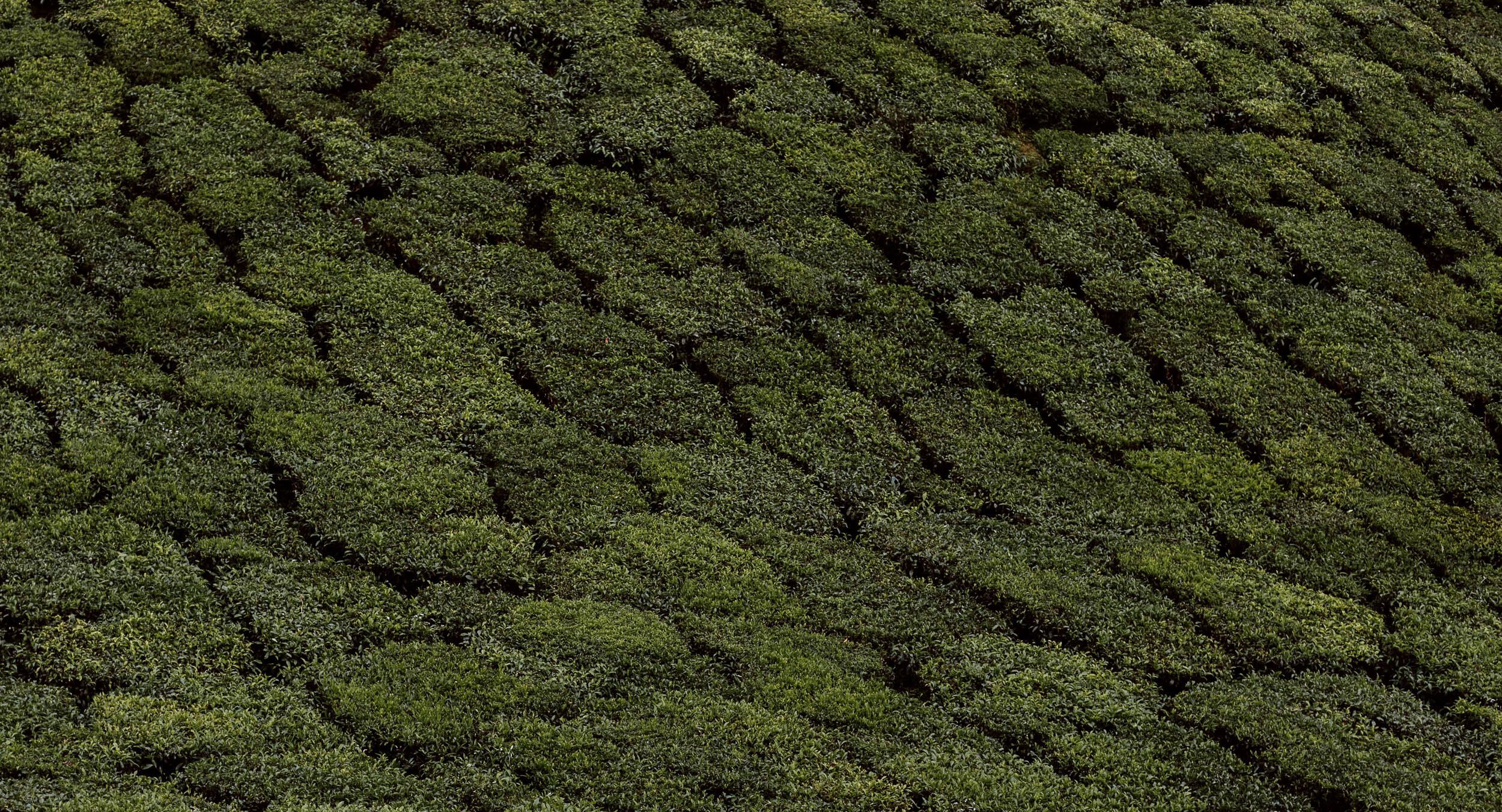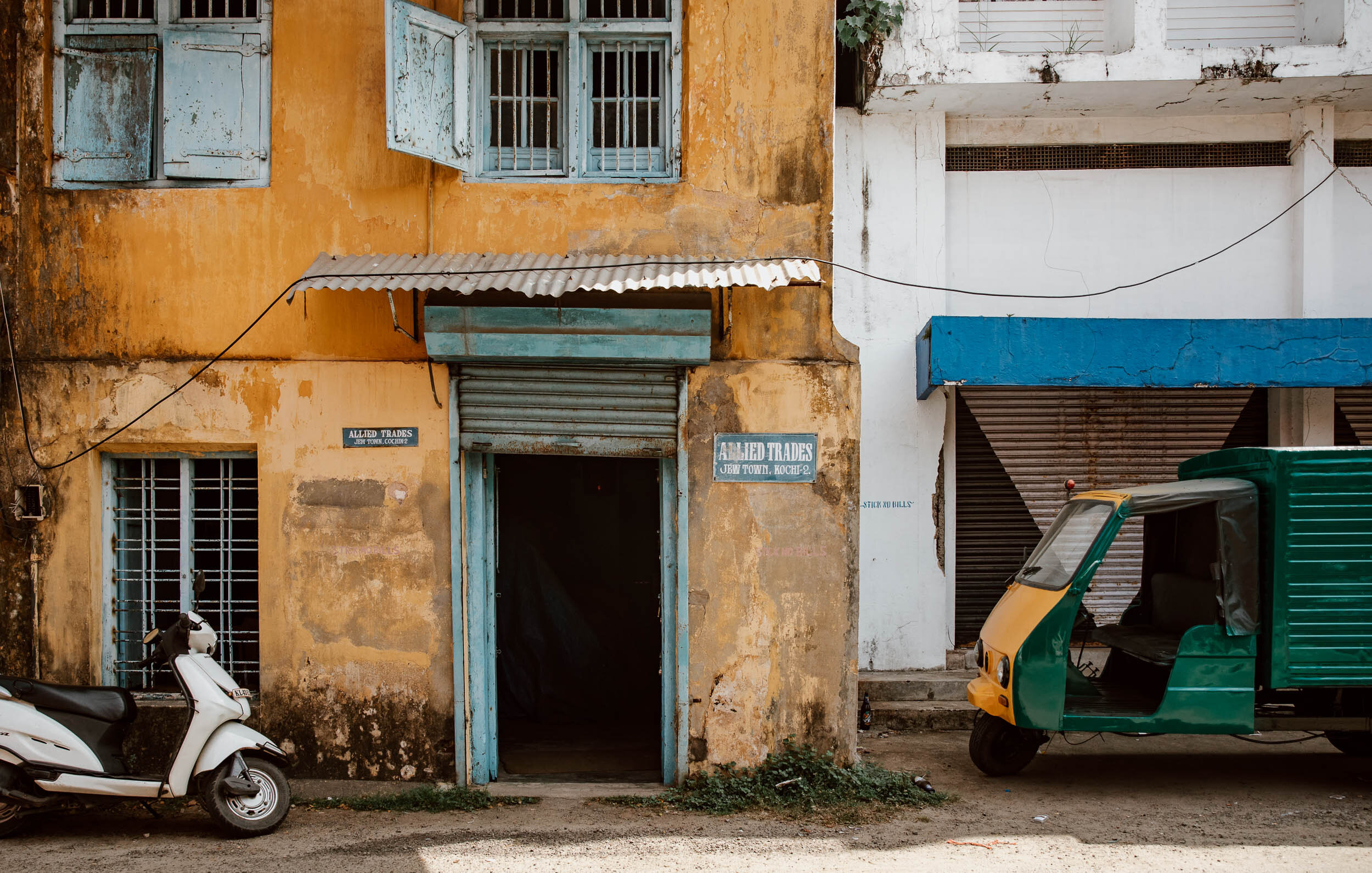If you're a little confused about how best to visit the beautiful Kerala backwaters, where they actually are or whether to stay on a houseboat, this is the post for you!
The boat was late, and hailed by a man waving a white towel.
Our group, composed of Europeans travellers and a solo holidaying Indian gentleman from Bangalore, shared a relief that a rusting steel roof, rather than the sliver of shade of the not-broad-enough palm leaf on the dusty path, would offer us more protection from a late afternoon sunlight which blinded and burned.
The local ferry, which had the appearance of a stunted battleship that should have been decommissioned several wars ago, rattled and belched from its belly and behind as it brought our tired, yet happy collective back to the jetty in the city of two names.
A scent of thick diesel spiralled and clung to the nostrils.
And yet the views through the caged window remained of a paradise where nothing rises above the banks of palm trees and storybook scenes play out in front single-storey Wes Anderson homes of pastel pinks and greens. A place where pensioners idle in long wooden boats and sun scorched leathery men plunder bounty from the rivers and the rice fields with knotted tree-root arms as young brothers dip and dive in their shared liquid playground, and brightly clothed women seek out a from beneath colourful umbrellas as they glide across the water.
The Kerala backwaters really are very special, no matter which vantage point you have; it was the end of a wonderful day.
Aside from the prospect of limitless curries, it was these backwaters which we hoped would be one of the true highlights of our three weeks travelling through the state. Experiencing the spindly, entwining waterways of Kerala would, we hoped, transport us to a peaceful idyll to contrast with the calls, the chaos, and the crowds that underpin many other travel experiences in India.
However, as they are mentioned so frequently in guides, we felt in our research that their reputation had perhaps preceded them a little; it was clear to everyone that they have to visit the Kerala backwaters, but we were left quite confused about what exactly constituted ‘the backwaters' and how best to do experience them as part of our own Kerala itinerary.
We also felt there was a lack of really useful information about the backwater houseboats, information which we think any responsible modern traveller will want to know in advance of actually stepping foot on one.
Therefore, we set out to not only experience the backwaters for ourselves, but also find some definitive answers to help future visitors like you plan.
In this post, we’ve shared the most important things to know before you visit the Kerala backwaters - including clear information on what they actually are, a definitive answer on the best place to start from, advice on the most environmentally friendly (and enjoyable) ways to experience them for your budget, and tips on the best homestays in the backwaters themselves.
What are the Kerala Backwaters?
Stretching across the state, the unique backwaters are composed of a web of lagoons, canals, and lakes which run parralell to the Malabar coast. Estimated to cumulatively cover around 900kms, these waterways have long been used as a transport network for agriculture, fishing, and the scattered rural communities which continue to reside at the water's edge.
A cursory glance at any map of Kerala, or any train ride through it, will quickly reveal just how widespread and pivotal these wetlands are to the people, the produce, and the prosperity of the region. And, although 'backwater' is more commonly used in a negative sense in English to refer to a place that's a bit behind or crap, in Kerala it could easily be used as a synonym for tranquil tropical paradise.
Insider Allepey Tips | Most travellers taking a boat or canoe out on the backwaters will therefore spend two nights in the Alleppey. The main beach here is actually pretty nice (and good for sunset), but we found the city didn’t offer too much else. We haven’t written our guide to Alleppey yet, but recommend the following:
Accommodation | We stayed at a lovely private double with AC and bathroom at Trippr, which was a new hostel. Just around the corner, you can also find the popular Zostel hostel. Both are in the same traveller-centric neighbourhood by the beach, and a Rs. 50 (£0.5 / €0.6 / $0.7) rickshaw ride there from the train station. If you prefer to stay in or around the ferry jetty rather than the beach, check out the popular Boho Homestay or the backwaters accommodation section later in this post.
Eating | Around the beach hostels area, there are really only a handful of restaurants for dinner. Upstairs at Cafe Catamaran is decent and chilled out, run by some hipster Indian dudes, whilst a little further down the same road on the left there’s a lovely little family-run restaurant (but we forgot to write the name down - sorry!) If you’re desperate for a beer (as we were), then the only place to go is the licensed Harbour Bar & Beer Parlour (Google Maps) - a 10-minute walk away along the main road (its veg pakora was worth the walk alone). If you’re a solo female traveller, note that it’s a very male-dominated space and best to go in a group at night.
So, Where Are The Kerala Backwaters?
In Kerala, obvs.
There are actually backwater networks all over the state, including in the south and north, and it is possible to visit a stretch of the backwaters from a variety of locations in Kerala. Indeed, we saw tours offered in Kochi, Varkala, and Thiruvananthapuram.
However, the Kerala backwaters are those found in and around the coastal city of Alleppey (also called Alappuzha); these are the waterways which people are most commonly referring to and what most people will visit on their trip.
Although you can visit a backwater stretch from Varkala on a short tour, or on foot like we did, they are not the Kerala backwaters which people talk about and don't have the same level of community life on their banks. Alternatively, most backwater tours from Fort Kochi (like this one) are likely to take you down the road to Alleppey, whilst Thiruvananthapuram simply takes you to Kollam.
Therefore Alleppey, an hour and a half drive or two-hour train journey from Kochi, is the place to go (or end up) for the full Kerala backwaters experience and it is undoubtedly the principal gateway to the Kerala backwaters for travellers like you.
Read Later | Our Guide To Fort Kochi
When is the best time to visit them?
October to late February or early March is the best time to visit the Kerala backwaters.
The chances of rain are low, and the temperature will be pleasantly sunny and high. However, note that period also coincides with tourism high season (running from around the 15th December to mid-January), and therefore sees prices and demand increasing with thousands of holidaying Indians visiting the region. We visited at the end of November, and the conditions were perfect.
It's still possible to visit the backwaters in the monsoon season (June - September), when it would be more verdant and vibrant, but it does obviously have the potential to be a total washout, so we'd advise to check conditions and weather reports closer to your visit.
The increased heat of the summer months (March-May) may be too much for many travellers to actually enjoy the experience. Again, check conditions and weather reports for your own trip.
How Do You Access The Kerala Backwaters?
Unsurprisingly, there are a variety of ways which modern day travellers can experience the Kerala backwaters - but all are not created equal!
We've provided a brief overview of each in this section, before giving you a lot more detail on the three most relevant options for your own trip in the rest of the post.
The Government Cruise | A scenic and very cheap option is the large government ferry tour between Kollam and Alleppey. There are daily departures from both Kollam and Alleppey at 10.30 a.m. from the DTPC jetty in the respective cities. The cruises run the same route, so there isn't a difference on where you start, but note that the only real reason to go to Kollam is to take this boat.
For reference, we’ve included directions to the Kollam jetty (Google Maps) and the Alleppey jetty (Google Maps).
The tour lasts about 8 hours, so it's a long day, but the ticket is only Rs 600 per person (£3.1 / €3.7 / $4.1). From reviews available online, people seem to enjoy this but it does become a little tedious and doesn't bring you to the narrow, more scenic areas due to the size of the vessel.
If you want to do this, we'd suggest that it's a good idea to take the 25-minute train from Varkala to Kollam, then take the boat to Alleppey (or vice-versa). You can see the full government cruise timetable and further information on the official website.
The Local's Ferry | Opting to just take one the cheap as chips small local's ferry from Alleppey out on the water in a random direction would be a memorable experience on its own merits. For those on a ridiculously tight budget this is an option to save money whilst having an interesting day, but do note that the chugging, dated ferry isn't terribly comfortable or relaxing, and does not visit the most picturesque areas.
The ferry cost is minimal with tickets starting from about 7 rupees, but depends on the route and journey as there are several every hour. Pay cash on board.
Some parts of the backwaters can actually also be accessed via road (they're not as remote as we thought they may be, but reaching them via a taxi would be a bit dull).
A Homestay | For independent travellers with a flexible schedule, you can pair the local ferry with a stay at a backwater homestay in Alleppey, such as Ayana’s Homestay, or one of the more luxurious boutique options like Warmth Lake Haven Resort. We've shared more advice on the best places stay in the Kerala backwaters later in this post.
A Houseboat | The backwater communities used kettuvallam boats to transport rice from the paddy fields to market town for centuries, but these boats have now evolved into the best-known tourist experiences in Kerala. If you’re reading this post, there’s a good chance that you may be considering a houseboat tour or overnight stay - and we think it’s important that you’re fully aware of their downsides . We discuss these, plus prices, in the next section.
The Canoe Tour | The idyllic and environmentally friendly option which we opted for and loved. It’s also excellent value - we've shared all the key info later in the post.
A Shikara | This old school covered longboat is much smaller than most houseboats, and provides a relatively fancy option for a relaxing day trip. However, most are actually only able to follow a similar route to the houseboats (despite what tour providers may tell you to the contrary).
Should You Do a Kerala Backwater Houseboat Tour?
Houseboats offer the unique opportunity to cruise the Kerala backwaters and spend a night sleeping out on the water, before returning to Alleppey the next morning. Service and meals are included on board, and it’s often held up as one of the best travel experiences in India.
However, after a lot of research, we chose to not take one.
Given the centrality of the industry to the economy of the city and its people (it’s the biggest employer in Alleppey), and that we didn't do it ourselves, we don't want to trash the Kerala backwaters houseboat experience in this post.
It may, after all, be something that you have your heart set on for the upcoming trip.
Nevertheless, there were several factors which made us hesitant to do a backwater houseboat tour before we even set foot in Alleppey (and which many guides gloss over); these concerns were immediately confirmed and added to once we hit the water.
We think any modern day responsible traveller will also want to know them before making a decision. Our goal after all is not to sell you a houseboat tour, but to help you make the best decision for your own trip, travel style, and budget; that's why we don't mind sharing both the positives and the negatives.
THE COST
A houseboat tour price is high relative to other experiences in Kerala, so it's important to factor it into your budget when planning.
The prices we were quoted in Alleppey ranged from Rs. 5,000 - 7,500 (£53-80 / €62-93 / $70-104) for the two of us a private double room with AC, including all meals on board - this was for a basic but acceptable vessel. As the quality of the boat is the greatest determinant on price however, there are houseboats costing in the range of Rs. 10,000 - 20,000 range per person, per night (£106-212 / €124-248 / $139-278).
However, the cost was not something which put us off a houseboat in Kerala, as we weren't travelling on a terribly strict budget for this trip and are always happy to pay a little more for a special experience on the road.
Tip | One of the best places to get an idea of typical pricing for a Kerala houseboat, and even book one, is on booking.com where it's possible to reserve approximately 65 boats. Just visit this page, and select ‘boat’ on the left hand side filter under ‘Property Type’.
THE CONGESTION + IMPACT
As we set off on the local morning ferry for the backwaters, we crossed paths with dozens of the large tar-black houseboats lurching back to port.
We were amazed at the sheer number of them and their intimidating size.
The Alleppey houseboats, which number over a thousand (and not all registered), dominate the main channels and thoroughfares of the backwaters and create a sense of congestion and traffic; this offers a surreal juxtaposition to what most of us will expect when thinking of a tranquil backwaters cruise.
Many we saw are the size of three houses, and far removed from the intimate kettuvallam of old.
They cause mini waves - which affect locals using small boats for transport or trade - and their diesel engines chug ceaselessly, creating noise and emitting fumes. In addition to this, many of the houseboats are wholly indiscriminate with their waste processing, both human and non-human, which has caused serious pollution and habitat damage in the backwaters.
On your own visit, you will quickly appreciate how much the local communities use and depend upon the waters for washing, cleaning, and bathing - all manner of daily rituals - and how much impact a daily stream of hundreds of large motorised houseboats must have on their drinking water, fishing stocks, and well-being.
The Department of Tourism has created a classification scheme for the Kerala boat houses, with the aim of evaluating their “safety and service standards”, and their environmental impact is factored into this. Houseboats which fulfil the minimum prescribed requirements will receive a ‘Silver Star’ classification, those meeting the minimums as well as 50% of the ten ‘optional conditions’ will have a ‘Gold Star’ status, whilst houseboats which “satisfy the essential conditions and adhere to eco-friendly measures…will be awarded the ‘Green Palm’ certificate”.
We don’t know the percentages of houseboats which meet these criteria, but at least it’s a start. However, it would be fantastic if the Green Palm measures were included in the minimum requirements for all houseboats to turn this into a sustainable and green mass tourism industry.
Read Later | 23 Things To Know Before You Visit Kerala
However, the houseboat industry’s status as the largest employer may also be contributing to over-dependence on it for tourism and the pernicious consequences. Essentially, there are too many boats being out on the water in high season. Such an outcome is unfortunately quite common when a destination’s economy is based around a single tourism activity, with the accompanying poor standards and poor regard for the environment ultimately creating a poor experience for visitors - which causes medium and long-term damage to both the destination and the industry.
There also appeared to be a worrying trend amongst a minority of Indian tourist groups who wanted the houseboat to be based around karaoke, music, and revelry. Such a preference, and given that the over-supply of houseboat operators means that such demands will inevitably be met (and encouraged) more frequently, creates a future crossroads for the Kerala houseboat experience to be decided whether relaxation, tranquility and curiosity are the central tenets, or parties.
We would love for Alleppey to be able to diversify its economy and backwaters offering so that an income from tourism isn't solely based around a houseboat, or that a half-decent job doesn’t have to be associated with one. Indeed, fewer houseboats, clearer standards on boat quality, and better environmental practices overall would help protect both the nature and communities of the backwaters in the long-term and allow for associated industry prices and incomes to increase.
THE ROUTE
Another positive initiative from the local government, which we applaud, is that houseboat engines have to be shut between 6.00 pm - 8.30 a.m., and they cannot move or travel in this period. For travellers, this means most houseboats will be parked up next to each other in clusters from the early evening to the morning. And, with the two day / one night cruise being the most popular option*, it’s important to know what this entails for your route.
The standard Alleppey houseboat schedule is:
Leave the city at 11 a.m. or midday
Slowly cruise the backwaters for 4-5 hours
Park by 6 p.m.
Depart at 8.30 a.m., arriving back in Alleppey by 10 a.m. the next day.
Reading reviews online, the docking at 6 p.m. with other boats hasn't been an issue at all for some people, but for others it was a surprise and they felt slightly trapped (resulting in a less isolated / special experience than anticipated). Either way, we’re just letting you know in advance.
Finally, the houseboats - whatever the quality, size, or cost per night - are only able to stick to the widest channels of the backwaters. This, alongside serious concerns about their impact, was the main reason that we chose a more sustainable option to explore the Kerala backwaters.
* There are actually three of four different two-day routes, but most houseboats will take you on the standard circuit and itinerary. You can go out on a houseboat for a day trip only, but we don't really see the point in that - better to go on the shikara or canoe.
How To Book A Kerala Houseboat
The multitude of houseboats we saw on the water and at the jetty in Alleppey ranged from old to new, relatively luxurious to disappointing decrepit, small and intimate to the large, multi-storey, multi-group ones the size of three houses. Some have the thatched roof and style of the traditional kettuvallam, may don't.
We unfortunately only saw a single traditional style small houseboat which you could stay in overnight, but even this now had an engine on it.
Therefore, it's really important to know the standard of houseboat and experience you're paying for in advance. If you're going to book online, make sure there are several reviews you can trust. Also, if you want a romantic or private boating experience, make certain that you don't end up on one of the massive multi-room barges with some randoms (a boat with an upper deck will also give you more opportunity for privacy away from the driver and others working on the vessel). For solo travellers however, your most economical option is to join a shared group boat.
You can research and book up to 65 houseboats here - just tick ‘boat’ on the left hand side filter - whilst there even a few good options over on Airbnb.
However, the most common way to book your houseboat is via your accommodation or tour company in Alleppey, or to go directly to the jetty and negotiate a deal for yourself. Depending on your time, experience, and budget, one option may appeal more than the other.
Read Later | Our Guide To Varkala, The Best Beach Town in Kerala
Our initial plan was to go to one the houseboat jetties (Google Maps) in the early morning to get a deal and set off the same day. However, as you know already, we went with a different option.
If you do go and negotiate, make sure you are able to see and inspect the boat, agree that all meals are included (and any dietary preferences), confirm how many other guests will be on the boat, whether your room is AC or fan-only, and get a clear agreement on final and total price per person. Please also enquire about what they do with waste and their classification status. If arranging your own houseboat in Alleppey, it's always a good idea to ask other travellers or those working at your accommodation for some advice on any potential scams or pitfalls (for example, paying a deposit or not), or recommendations. Similarly, if someone had a positive experience with a specific company or boatman, get the details off them to save time and hassle when researching your own trip.
Alternatively, if you want to avoid the hassle entirely and would prefer to book in advance online with certainty, you can do this highly-rated two-day houseboat experience with private transport to/from Fort Kochi - find out more here here.
A Canoe Tour on The Kerala Backwaters Is Wonderful
Houseboats will not die a death due to their enduring popularity with the many Indian tourists who holiday in Kerala; the number of families and large groups of friends that we saw on a single day before high season started made that abundantly clear.
However, we really think that the better option is the canoe trip along the backwaters.
Several travellers down in Varkala had highly recommended it to us and, the more research we did into it the more positive we felt that this would be the most sustainable and responsible way to visit the Kerala backwaters. Here's why:
Transport to and from the backwaters uses the local ferry.
The small wooden canoes, which hold up to 6 people and the pilot, do not use any engine. Instead, a local man works bloody hard in the heat to navigate the backwaters using his strength and a wooden pole. This stops your visit creating or adding to the houseboat pollution.
The waste created on the waterways from your meals or hygiene requirements is processed and disposed of at the local home where you have breakfast and lunch, rather than simply being tossed overboard.
Our canoe trip directly engaged / employed 6 people who live in a backwater community, in addition to the tour operator.
Above and beyond all those advantages, the serene canoe trip allowed access the narrow backchannels where traditional village life continues away from the clogged up aquatic arteries. This aspect was the highlight of our tour and, as mentioned, the houseboats cannot access these areas.
How To Book A Backwater Canoe Tour
After arriving in Alleppey by train, we checked-in to our hostel (Trippr - check availability here) and were able to easily book a place for the next morning’s canoe tour with their preferred provider Oscar Cruise.
The price, including all transport, breakfast, and lunch, was only 1,000 rupees each (£10.6 /€ 12.4 / $13.9) - an absolute bargain.
The day started with an 8 a.m. tuk-tuk pick-up at the hostel, which brought us to the meeting point at the local ferry terminal where the other group members were waiting. In total there were 14 of us, which was a larger group than we had expected but still manageable. The ferry took us out to a small settlement out on the backwaters where a tasty local breakfast of puttu and glasses of milky, sweet chai was devoured, before everyone was split out into the covered open-side canoes (4-6 people per boat). It was then a very relaxing, chilled out journey of three hours down the main waterways and the narrow backchannels, with a stop at a local stand for freshly hacked coconuts or drinks. The group then returned for a small, freshly prepared thali lunch served on banana leaf, before being walked back to catch the ferry and be picked up by a tuk-tuk in Alleppey.
It was a really lovely, serene day - and we felt privileged to experience it; the tour underlined that we really didn’t need a houseboat after all to enjoy and experience the Kerala backwaters at their best.
All hostels and hotels in Alleppey are able to book a Kerala backwaters canoe tour for you, and we'd recommend this for ease.. A sunset canoe cruise is also available, or you could take a look at doing it via a kayak tour with Kerala Kayaking.
Lastly, please remember to give your canoe pilot a tip at the end. This isn't mandatory, but given that the tour itself is cheap and that the guy is putting in a hell of a shift out in the sun, he's definitely earned a little extra.
You Can Stay on the Kerala Backwaters Without a Houseboat
We still have a tinge of regret about not doing this.
Indeed, on the ferry back to Alleppey after our canoe tour, we had intentionally noted names of a few of the guesthouses facing the main waterfront, and started looking into backwater accommodation options once back at our hostel.
We thought a night or two out on the backwaters would offer up excellent opportunities to meet more locals, visit a toddy shop, walk around on our own, and hopefully create some special photography portraits. Indeed, when staying on the backwaters, travellers can also rent out their own kayaks or arrange a boat / canoe, do a walking tour, take a cooking class, amble around independently, try your hand at fishing, or rent a bike to cycle between villages and paddy fields.
It sounded like a really nice way to get to know them a little better.
There are various resorts on the backwaters, such as Malayalam Lake, Riverdale Villa, or the very fancy Warmth Lake Haven (waaaay nicer than the name suggests), but our heart was set on a local guesthouse. Although the quality varies quite a lot, some of the best options we found were:
Ayana's Homestay | Accessed only by boat, this grand building on the water’s edge has fantastic guest reviews for the hospitality, the setting, and the home cooked family dishes prepared each evening for guests. The rooms look clean and comfortable too, making it one of the better value backwater homestays around. Check availability or make a reservation here.
Backwater Breeze | Set on the river bank in a small village, this is a highly-rated option even though it’s perhaps a little pricier than it should be. Previous guests have nothing but kind words to say about the owners Varghese and Sheelma. Check availability or make a booking here.
Riverville | We think this family-run homestay is one for the older traveller, or those looking for more modern comfort and facilities in a homestay. Its quiet location is perfect to make the most of the backwaters however, with views of the water and rice fields. Check availability or make a booking here.
Lemon Dew | Right on the backwaters and immersed in nature, it’s basic and a little out of the way but perfect for backpackers. The owner Anoop organise canoe tours, and also takes some wonderfully random photos of a guest who looks like a young Big Lebowski. Check availability or make a booking here.
Greenpalm Homestay | Due to its feature in the Lonely Planet, it’s not a surprise that Greenpalm remains one of the most popular backwater homestay. It has now grown into a group of properties, with basic to premium rooms available and prices to match. Find out more, or check availability, here.
It’s recommended to contact the host before you arrive to confirm the best way to reach the guesthouse and estimated prices for the boat / tuk-tuk.
Unfortunately, many of the available options at last-minute were ‘on the backwaters’ but basically in Alleppey facing the busiest part of the backwaters, rather than being in a remote location. We also felt that the pricing for some was out of sync with our expectations and the quality of the accommodation (relative to what we paid elsewhere in Kerala),
We know the experience would have been very memorable and could have afforded it, but we ultimately decided to prioritise other places on our itinerary.
In hindsight, with a little more advance planning, we could have opted to go directly to a homestay on the backwaters, explore for a day in a canoe or kayak on our own, and then have a night or two out there. This would have been instead of staying by the beach in Alleppey. However, since we had such a lovely experience with the canoe, we don’t kick ourselves about it too much.
To get an overview of all accommodation options out on the Kerala Backwaters for your travel style and budget, check out the specific Alleppey page on booking.com or the large number of homestays available over on Airbnb. Just remember that many places which advertise themselves as a backwaters homestay, may actually be in or very close to the city rather than in a more rural / aquatic location.
If you do a Kerala backwaters homestay there or elsewhere, and think others should know about it, tell us about it in the comments!
What You Need To Bring To The Backwaters
Water | The most important thing given the heat and length of time you'll be out. We've travelled in India, South America, and Africa with our Water-to-Go travel filter water bottles, which give us instant access to safe drinking water everywhere and dramatically reduced our single-plastic usage on the road. We highly recommend you get one for your own Kerala trip (and for future adventures) - or check out the more expensive Grayl bottle alternative. The canoe trip did also include a stop at a shop for coconuts and drinks, whilst the breakfast and lunch place sold single-use plastic bottled water for people who didn't think to bring their own source.
If you don’t know about travel filter water bottles, and why they’re so essential for travellers, read this post which explains everything.
Suncream | Although you'll be in the shade for most of your canoe or houseboat tour, it can get very hot out there and there will be several moments when you're in strong direct sunlight. Slap it on.
Bug spray | During our canoe trip there weren’t too many bugs, but it’s recommended to bring a bottle with you anyway (especially if you’re staying anywhere by the water overnight). We have used this all natural DEET-free bug spray by incognito for the last four years all over the world, and it’s bloody fantastic. Seriously.
Hat & Sunglasses | Note that there's no need to bring swimming stuff as you won't be going in the water.
Straw | For sipping coconuts and soft-drinks from the glass in India, every traveller should invest in a metal or bamboo straw. We use this one - it's practical, hygenic, and cuts down on tourists creating and adding to needless single-use plastic waste
Find out more about why you should travel with less plastic - and our advice on how exactly to do it.
Responsible Photography Advice
If it’s your first time on Along Dusty Roads, then firstly - hello! Secondly, you may not know that we’re big on street photography at home and when we travel.
As the backwaters are so damn beautiful and unique, every traveller will want to take photos. However, if you go down the narrow channels, please note that you are getting up very close and personal to someone’s home, wash room, and private space. The couple who shared our canoe showed very little concern about taking (probably long forgotten now) photos of an old man washing and women doing their laundry - for us, this just wasn’t appropriate or worth it.
As street photographers, that may seem a bit hypocritical, but we both strongly felt in the small and intimate setting of the back canals, it was a place to show restraint with a camera and appreciate it with your eyes rather than go click-heavy.
